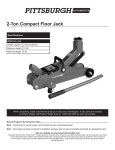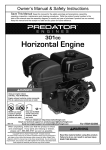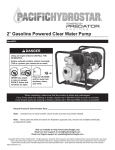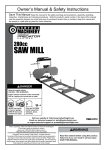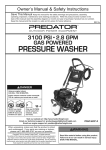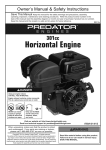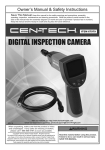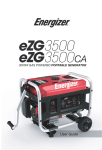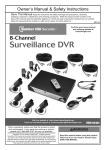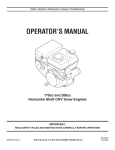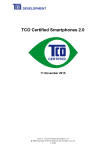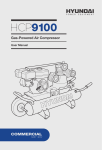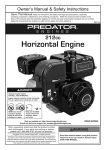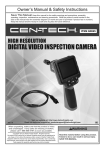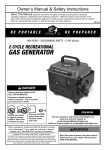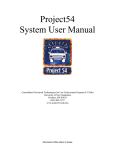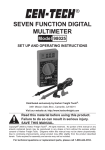Download Owner`s Manual & Safety Instructions Owner`s Manual & Safety
Transcript
Owner’s Manual & Safety Instructions Save This Manual Keep this manual for the safety warnings and precautions, assembly, operating, inspection, maintenance and cleaning procedures. Write the product’s serial number in the back of the manual near the assembly diagram (or month and year of purchase if product has no number). Keep this manual and the receipt in a safe and dry place for future reference. REV 15l Using an engine indoors CAN KILL YOU IN MINUTES. Engine exhaust contains carbon monoxide. This is a poison you cannot see or smell. NEVER use inside a home or garage, EVEN IF doors and windows are open. Only use OUTSIDE and far away from windows, doors, and vents. Visit our website at: http://www.harborfreight.com Email our technical support at: [email protected] Email our engine support at: [email protected] When unpacking, make sure that the product is intact and undamaged. If any parts are missing or broken, please call 1-888-866-5797 as soon as possible. Copyright© 2015 by Harbor Freight Tools®. All rights reserved. No portion of this manual or any artwork contained herein may be reproduced in any shape or form without the express written consent of Harbor Freight Tools. Diagrams within this manual may not be drawn proportionally. Due to continuing improvements, actual product may differ slightly from the product described herein. Tools required for assembly and service may not be included. Read this material before using this product. Failure to do so can result in serious injury. SAVE THIS MANUAL. Table of Contents Specifications.............................................. 2 Safety��������������������������������������������������������� 3 Setup........................................................... 8 Operationr��������������������������������������������������� 10 Maintenances���������������������������������������������� 16 Troubleshooting.......................................... 22 Parts List and Diagram............................... 24 Warranties.................................................. 27 Specifications Front Tine Tiller Specifications Maximum Tilling Depth Maximum Tilling Width Drive Type Drive Actuation Depth Adjustment Steps Overall Dimensions Wheels Weight 6.5" (165 mm) 26" (660 mm) Belt and Chain Clutch Drive (Handle Lever Operated) 6 51" L x 25" W x 42-1/2" H 8" Diameter x 1-3/4" W 118 Pounds Engine Specifications Displacement Engine Type Cooling System Type Fuel Capacity Engine Oil Type SAE Capacity Sound Level at 1 meter Bore x Stroke Compression Ratio Rotation viewed from PTO (power takeoff - the output shaft) Spark Plug Valve Clearance Speed Type Gap Intake Exhaust Idle 208cc Horizontal Single Cylinder 4-stroke Forced air cooled 87+ octane unleaded gasoline treated with fuel stabilizer 0.66 Gallon (2.5 Liter) 10W-30 above 32° F 5W-30 at 32° F or below 20 ounces (0.6 Liter) 95 dB 70 mm x 54 mm 8.8:1 Counterclockwise Torch® F6TC 0.0275" – 0.0314" 0.0059" – 0.0078" 0.0059"– 0.0078" 1560 ± 50 RPM The emissions control system for this Engine is warranted for standards set by the U.S. Environmental Protection Agency. For warranty information, refer to the last pages of this manual. Page 2 For technical questions, please call 1-888-866-5797. ITEM 62548 WARNING SYMBOLS AND DEFINITIONS This is the safety alert symbol. It is used to alert you to potential personal injury hazards. Obey all safety messages that follow this symbol to avoid possible injury or death. Safety Indicates a hazardous situation which, if not avoided, will result in death or serious injury. Indicates a hazardous situation which, if not avoided, could result in death or serious injury. Indicates a hazardous situation which, if not avoided, could result in minor or moderate injury. Addresses practices not related to personal injury. RPM HP Property or Statement Revolutions Per Minute Horsepower WARNING marking concerning Risk of Eye Injury. Wear ANSI-approved safety goggles with side shields. Read the manual before set-up and/or use. Property or Statement WARNING marking concerning Risk of Respiratory Injury. Operate engine OUTSIDE and far away from windows, doors, and vents. WARNING marking concerning Risk of Fire while handling fuel. Do not smoke while handling fuel. WARNING marking concerning Risk of Fire. Do not refuel while operating. Keep flammable objects away from engine. Maintenance WARNING marking concerning Risk of Hearing Loss. Wear hearing protection. Symbol Operation Symbol Setup Symbol Definitions ITEM 62548 For technical questions, please call 1-888-866-5797. Page 3 IMPORTANT Safe Operation Practices for Walk-Behind Powered Rotary Tillers and Hand Supported Cultivators Safety Training 1. Read the operating and service instruction manual carefully. Be thoroughly familiar with the controls and the proper use of the equipment. Know how to stop the unit and disengage the controls quickly. 2. Never allow children to operate the equipment. Never allow adults to operate the equipment without proper instruction. 3. Keep the area of operation clear of all persons, particularly small children, and pets. 4. Keep in mind that the operator or user is responsible for accidents or hazards occurring to other people, their property, and themselves. Preparation Setup 1. Thoroughly inspect the area where the equipment is to be used and remove all foreign objects. 5. Never attempt to make any adjustments while the engine is running. 2. Disengage all clutches and shift into neutral before starting the engine. 6. Have multiple ABC class fire extinguishers nearby. 3. Do not operate the equipment without wearing adequate outer garments. Wear protective footwear that will improve footing on slippery surfaces. 4. Warning: Fuel is highly flammable. Take the following precautions: (a)Store fuel in containers specifically designed for this purpose. (b)Refuel outdoors only and do not smoke while refueling. Operation (c)Add fuel before starting the engine. Never remove the cap of the fuel tank or add fuel while the engine is running or when the engine is hot. (d)If fuel is spilled, do not attempt to start the engine but move the machine away from the area of spillage and avoid creating any source of ignition until fuel vapors have dissipated. (e)Replace all fuel tank and container caps securely. 7. Operation of this equipment may create sparks that can start fires around dry vegetation. A spark arrestor may be required. The operator should contact local fire agencies for laws or regulations relating to fire prevention requirements. 8. Set up and use only on a flat, level, well‑ventilated surface. 9. Wear ANSI-approved safety goggles, heavy-duty work gloves, and dust mask/respirator during set up. 10. Use only lubricants and fuel recommended in the Specifications chart of this manual. 11. NEVER till above or near any electrical cables, gas pipes, or any other utility lines. Contact your local utility company before using the Front Tine Tiller. 12. Thoroughly inspect the area where the Front Tine Tiller is to be used. Beware of possible buried obstacles such as cable, conduit, irrigation lines, and landscape fabric. Remove all large sticks, stones, wires, or other foreign objects. Maintenance Page 4 For technical questions, please call 1-888-866-5797. ITEM 62548 Operation 2. Exercise extreme caution when operating on or crossing gravel drives, walks, or roads. Stay alert for hidden hazards or traffic. Do not carry passengers. 3. After striking a foreign object, stop the engine, remove the wire from the spark plug, thoroughly inspect the machine for any damage, and repair the damage before restarting and operating the machine. 22. Do not operate the tiller while under the influence of alcohol or drugs. 23. CARBON MONOXIDE HAZARD Using an engine indoors CAN KILL YOU IN MINUTES. Engine exhaust contains carbon monoxide. This is a poison you cannot see or smell. Safety 1. Do not put hands or feet near or under rotating parts. 4. Exercise caution to avoid slipping or falling. 5. If the unit should start to vibrate abnormally, stop the engine and check immediately for the cause. Vibration is generally a warning sign of trouble. NEVER use inside a home or garage, EVEN IF doors and windows are open. 9. Do not operate the engine in a confined space where dangerous carbon monoxide gas can collect. 10. Never operate the machine without proper guards, plates, or other safety protective devices in place. 11. Keep children and pets away. 12. Do not overload the machine capacity by attempting to till too deep at too fast a rate. 13. Never operate the machine at high transport speeds on hard or slippery surfaces. 14. Never allow bystanders near the unit. 15. Use only attachments and accessories approved by the manufacturer of the machine (such as wheel weights, counterweights, and the like). 16. Never operate the tiller without good visibility or light. 17. Be careful when tilling in hard ground. The tines may catch in the ground and propel the tiller forward. If this occurs, let go of the handlebars and do not restrain the machine. 18. Use extreme caution when reversing or pulling the machine towards you. 19. Do not change the engine governor settings or overspeed the engine. 20. Start the engine carefully according to instructions and with feet well away from the tines 21. Never pick up or carry a machine while the engine is running. ITEM 62548 Only use OUTSIDE and far away from windows, doors, and vents. 24. DO NOT engage the Forward and Reverse Clutch Levers at the same time. This will result in unpredictable Tiller behavior and possible equipment damage. 25. Do not use the Front Tine Tiller on steep inclines. Use only on level ground surfaces. 26. Keep a safe distance from the edges and banks of ditches. Avoid any actions that may cause the Tiller to tip over. Operation 8. Before cleaning, repairing, or inspecting, shut off the engine and make certain all moving parts have stopped. Disconnect the spark plug wire, and keep the wire away from the plug to prevent accidental starting. Setup 7. Take all possible precautions when leaving the machine unattended. Disengage the power take-off, lower the attachment, shift into neutral, stop the engine, and remove the key. 27. Do not touch engine during use. Let engine cool down after use. 28. Industrial applications must follow OSHA requirements. 29. The equipment can produce high noise levels. Prolonged exposure to noise levels above 85 dBA is hazardous to hearing. Wear ear protection when operating the equipment. 30. Wear ANSI-approved safety glasses, hearing protection, heavy‑duty work gloves and steel-toed boots during use. 31. People with pacemakers should consult their physician(s) before use. Electromagnetic fields in close proximity to a heart pacemaker could cause pacemaker interference or pacemaker failure. Caution is necessary when near the engine’s magneto or recoil starter. 32. Do not operate in explosive atmospheres, such as in the presence of flammable liquids, gases, or dust. Gasoline-powered engines may ignite the dust or fumes. For technical questions, please call 1-888-866-5797. Page 5 Maintenance 6. Stop the engine when leaving the operating position, before unclogging the tines, and when making any repairs, adjustments, and inspections. 33. Use this equipment with both hands only. Using equipment with only one hand can easily result in loss of control. Safety 34. Dress properly. Do not wear loose clothing or jewelry. Keep hair, clothing and gloves away from moving parts. Loose clothes, jewelry or long hair can be caught in moving parts. 35. Parts, especially exhaust system components, get very hot during use. Stay clear of hot parts. 36. Do not cover the equipment during operation. 37. Keep the equipment, engine, and surrounding area clean at all times. 38. Do not operate the equipment with known leaks in the engine’s fuel system. 39. WARNING: This product contains or, when used, produces a chemical known to the State of California to cause cancer and birth defects or other reproductive harm. (California Health & Safety Code § 25249.5, et seq.) 40. WARNING: This product contains di (2-ethylhexyl) phthalate (DEHP), a chemical known to the State of California to cause cancer and birth defects or other reproductive harm. (California Health & Safety Code § 25249.5, et seq.) 41. When spills of fuel or oil occur, they must be cleaned up immediately. Dispose of fluids and cleaning materials as per any local, state, or federal codes and regulations. Store oil rags in a bottom-ventilated, covered, metal container. 42. Before use, check for misalignment or binding of moving parts, breakage of parts, and any other condition that may affect the equipment’s operation. If damaged, have the equipment serviced before using. Many accidents are caused by poorly maintained equipment. 43. Do not modify the Tiller and do not use the Tiller for a purpose for which it is not intended. Setup Operation Maintenance Page 6 For technical questions, please call 1-888-866-5797. ITEM 62548 Maintenance and Storage 3. Never store the machine with fuel in the fuel tank inside a building where ignition sources are present, such as hot water and space heaters, clothes dryers, and the like. Allow the engine to cool before storing in any enclosure. 4. Always refer to the operator’s manual for important details if the tiller is to be stored for an extended period. 5. If the fuel tank has to be drained, do this outdoors. 6. Follow manufacturer’s recommendations for safe loading, unloading, transport, and storage of machine. 7. Before service, maintenance, or cleaning: a. Turn the Engine Switch to its “OFF” position. b. Allow the Engine to completely cool. c. Then, remove the Spark Plug Cap from the Spark Plug. 9. Do not store fuel or other flammable materials near the engine. Safety 2. Check shear bolts, engine mounting bolts, and other bolts at frequent intervals for proper tightness to be sure the equipment is in safe working condition. 8. Do not alter or adjust any part of the equipment or its engine that is sealed by the manufacturer or distributor. 10. Wear ANSI-approved safety goggles, heavy‑duty work gloves, and dust mask/respirator during service. 11. Maintain labels and nameplates on the equipment. These carry important information. If unreadable or missing, contact Harbor Freight Tools for a replacement. 12. Have the equipment serviced by a qualified repair person using only identical replacement parts. This will ensure that the safety of the equipment is maintained. Do not attempt any service or maintenance procedures not explained in this manual or any procedures that you are uncertain about your ability to perform safely or correctly. 13. Store equipment out of the reach of children. 14. Follow scheduled engine and equipment maintenance. Setup 1. Keep machine, attachments, and accessories in safe working condition. WARNING! Read all instructions. Failure to follow all instructions listed below may result in fire, serious injury and/or DEATH. The warnings and precautions discussed in this manual cannot cover all possible conditions and situations that may occur. It must be understood by the operator that common sense and caution are factors which cannot be built into this product, but must be supplied by the operator. Maintenance Operation SAVE THESE INSTRUCTIONS. ITEM 62548 For technical questions, please call 1-888-866-5797. Page 7 Set Up Read the ENTIRE IMPORTANT SAFETY INFORMATION section at the beginning of this manual including all text under subheadings therein before set up or use of this product. Safety TO PREVENT SERIOUS INJURY: Operate only with proper spark arrestor installed. Operation of this equipment may create sparks that can start fires around dry vegetation. A spark arrestor may be required. The operator should contact local fire agencies for laws or regulations relating to fire prevention requirements. TO PREVENT SERIOUS INJURY FROM ACCIDENTAL STARTING: Turn the Power Switch of the equipment to its “OFF” position, wait for the engine to cool, and unplug the spark plug wire(s) before assembling or making any adjustments to the equipment. At high altitudes, the engine’s carburetor, governor (if so equipped), and any other parts that control the fuel-air ratio will need to be adjusted by a qualified mechanic to allow efficient high-altitude use and to prevent damage to the engine and any other devices used with this product. Note: For additional information regarding the parts listed in the following pages, refer to the Assembly Diagram near the end of this manual. Setup Assembly Attach the Handlebar Assembly to the Handlebar Frame (49) using four Hex Head Flange Bolts (72), Flat Washers (66), Spring Washers (67), and Nuts (62). Refer to Figure A. Handlebar Assembly Operation Flat Washer, Spring Washer & Nut Flange Bolt Maintenance Handlebar Frame Figure A Page 8 For technical questions, please call 1-888-866-5797. ITEM 62548 Engine Switch Forward Clutch Lever Reverse Clutch Lever Muffler Fuel Cap Setup Throttle Control Safety Components and Controls Oil Cap/ Dipstick Air Filter Oil Drain Plug Fuel Valve Maintenance Choke Starter Handle Tines ITEM 62548 For technical questions, please call 1-888-866-5797. Operation Drag Bar Page 9 Operation Read the ENTIRE IMPORTANT SAFETY INFORMATION section at the beginning of this manual including all text under subheadings therein before set up or use of this product. Safety Engine and Equipment Pre-Start Checks Inspect engine and equipment looking for damaged, loose, and missing parts before set up and starting. If any problems are found, do not use equipment until fixed properly. Checking and Filling Engine Oil NOTICE: Your Warranty is VOID if the engine’s crankcase is not properly filled with oil before each use. Before each use, check the oil level. Engine will not start with low or no engine oil. 1. Make sure the engine is stopped and is level. 2. Close the Fuel Valve. Setup 3. Clean the top of the Dipstick and the area around it. Remove the Dipstick by turning it counterclockwise, and wipe it off with a clean, lint free rag. 4. Reinsert the Dipstick without threading it in and remove it to check the oil level. The oil level should be up to the full level as shown at right. Full level 5. If the oil level is at or below the low mark add the appropriate type of oil until the oil level is at the proper level. SAE 10W‑30 oil is recommended for general use. (The SAE Viscosity Grade chart on page 18 in the Maintenance section shows other viscosities to use in different average temperatures.) 6. Thread the dipstick back in clockwise. NOTICE: Do not run the engine with too little oil. The engine will shut off if too little engine oil is used. Operation Maintenance Page 10 For technical questions, please call 1-888-866-5797. ITEM 62548 Checking and Filling Fuel 1. Clean the Fuel Cap and the area around it. 2. Unscrew and remove the Fuel Cap. 3. Remove the Strainer and remove any dirt and debris. Then replace the Strainer. 4. If needed, fill the Fuel Tank to about 1 inch under the fill neck of the Fuel Tank with 87 octane or higher unleaded gasoline that has been treated with a fuel stabilizer additive. Follow fuel stabilizer manufacturer’s recommendations for use. 5. Then replace the Fuel Cap. 6. Wipe up any spilled fuel and allow excess to evaporate before starting engine. To prevent FIRE, do not start the engine while the smell of fuel hangs in the air. Maintenance Operation Setup Note: Do not use gasoline containing more than 10% ethanol (E10). Do not use E85 ethanol. Add fuel stabilizer to the gasoline or the Warranty is VOID. Note: Do not use gasoline that has been stored in a metal fuel container or a dirty fuel container. It can cause particles to enter the carburetor, affecting engine performance and/or causing damage. Safety WARNING! TO PREVENT SERIOUS INJURY FROM FIRE: Fill the fuel tank in a well-ventilated area away from ignition sources. If the engine is hot from use, shut the engine off and wait for it to cool before adding fuel. Do not smoke. ITEM 62548 For technical questions, please call 1-888-866-5797. Page 11 Starting the Engine Before Starting the Engine a. Inspect the equipment and engine. Safety b. Fill the engine with the proper amount and type of both oil and unleaded gasoline treated with fuel stabilizer. c. Make sure that the Forward and Reverse Clutch Levers are disengaged. 1. To start a cold engine, move the Choke to the START position. To restart a warm engine, leave the Choke in the RUN position. 1 Setup Operation 2. Open the Fuel Valve. 2 3. Rotate the Throttle Control clockwise to halfway between the low and high position. 3 Maintenance 4. Turn the Engine Switch on. 4 Note: If engine does not start, check engine oil. Engine will not start with low or no engine oil. Page 12 For technical questions, please call 1-888-866-5797. ON ITEM 62548 Note: Do not let the Starter Handle snap back against the Engine. Hold it as it recoils so it doesn't hit the Engine. 5 Safety 5. Grip the Starter Handle of the Engine loosely and pull it slowly several times to allow the gasoline to flow into the Engine’s carburetor. Then pull the Starter Handle gently until resistance is felt. Allow Cable to retract fully and then pull it quickly. Repeat until the Engine starts. 6. Allow the Engine to run for several seconds. Then, if the Choke lever is in the START position, move the Choke lever very slowly to its RUN position. Note: Moving the Choke lever too fast could stall the engine. 6 IMPORTANT: Allow the Engine to run at no load for five minutes after each start‑up so that the Engine can stabilize. 7. Adjust the Throttle Control Lever as needed. Setup Break-in Period: a. Breaking-in the engine will help to ensure proper equipment and engine operation. b. The operational break-in period will last about 3 hours of use. During this period: • Do not apply a heavy load to the equipment. • Do not operate the engine at its maximum speed. c. The maintenance break-in period will last about 20 hours of use. • Change the engine oil after this period. Maintenance Operation Under normal operating conditions subsequent maintenance follows the schedule explained in the Maintenance section. ITEM 62548 For technical questions, please call 1-888-866-5797. Page 13 Tiller Operation Safety BEWARE of possible buried obstacles such as cable, conduit, irrigation lines, and landscape fabric. DO NOT till above or near any electrical cables, gas pipes, or any other utility lines. Contact your local utility company before using the Front Tine Tiller. 1. Before starting the Engine, set the desired tilling depth (to a maximum 6.5" deep) by adjusting the Drag Bar (91) and Wheel Assembly: a. To adjust the Drag Bar remove the R-Clip (35) and Clevis Pin (78). Lower the Drag Bar to increase tilling depth or raise Bar to decrease depth. Replace the Clevis Pin and R-Clip. Refer to Figure B. Setup b. Set the Drag Bar below the level of the Wheel Assembly. If necessary, remove the R-Clip (35) and Clevis Pin (77) from the Wheel Assembly and adjust as needed. Replace the Clevis Pin and R-Clip. 4. Grip the Handles firmly with both hands. 5. To move the Tiller in a forward direction, make sure the Reverse Clutch Lever (90) is not engaged and squeeze down on the Forward Clutch Lever (89) to rotate the Tines and move forward. Release the Forward Clutch Lever to stop Tine rotation and forward movement. Refer to Figure C. 6. To move the Tiller in a reverse direction, make sure the Forward Clutch Lever is not engaged and pull up on the Reverse Clutch Lever to rotate the Tines and move in reverse. Release the Reverse Clutch Lever to stop Tine rotation and backward movement. Note: Optimum tilling depth (generally 4"– 6") will vary with soil conditions. If Tiller shakes or is difficult to control, the Drag Bar and Wheel Assembly are not correctly set for the conditions. Adjustment through trial and error is required to achieve the correct setting. 2. WARNING! Before first use, practice operating the Tiller controls with Tines raised off of the ground. Know how to keep control at all times, how to stop the Tines from turning, and how to stop the Engine. For actual field use, operate with Throttle Control in slow position until familiar with Tiller handling. Operation Clevis Pin (77) Drag Bar (91) Clevis Pin (78) R-Clip (35) Engaged Disengaged Forward Clutch Lever Disengaged Engaged Reverse Clutch Lever Figure C 7. The following soil conditions can affect tilling results: a. On soil that is too hard and/or dried out for the Tines to penetrate, the Tiller will shake excessively and jump across the soil surface. Moisten dry, hardened soil prior to tilling and use a shallow depth setting and slow Engine speed. b. Exceedingly wet soil will form clumps during tilling and clog the Tines. Allow wet soil to partially dry before tilling and use a slow Engine speed to improve results. Maintenance R-Clip (35) Wheel Assembly Figure B 3. Start the Engine following instructions in Manual Start on page 12. Page 14 CAUTION! DO NOT engage the Forward and Reverse Clutch Levers at the same time. This will result in unpredictable Tiller behavior and possible equipment damage. NOTICE: Should the Tines jam or the Tiller strike a foreign object during use, immediately release the Clutch Lever and turn off the Engine. Wait until the machine completely stops. Disconnect the Spark Plug cap, remove foreign objects and inspect the Tiller. If any damage is found have the problem corrected before further use. For technical questions, please call 1-888-866-5797. ITEM 62548 Narrow Width Tilling c. Make sure the outer Tine Blades are removed from both Tine Blade Assemblies before operating Tiller. a. Make sure the Engine Switch is in the “OFF” position and disconnect the Spark Plug cap. b. Loosen and remove four sets of Bolts (59), Spring Washers (60), and Nuts (61) securing the outer Tine Blades in place on the Tine Shaft of each Tine Blade Assembly. Remove the Blades and set aside with the hardware. Refer to Figure D. d. To return to normal width tilling replace the outer Tine Blades onto both Tine Shafts. When reattaching the Tine Blades make sure the Blades and hardware are replaced in the same orientation as when removed. Safety The Tiller may be set up for narrow tilling by removing the outer Tine Blades from each of the two Tine Blade Assemblies using the following procedure: Note: When installed properly the cutting edges of the Tine Blades will face forward. Setup Note: Examine Tine Blade positioning and hardware alignment before removal to make correct reattachment easier. Tine Shaft Tine Shaft Bolt Nut Tine Blade Tine Blade Tine Blade Assembly with outer Tine Blades removed from Tine Shaft. Spring Washer Figure D Operation Stopping the Engine and Tiller 1. To stop the Engine in an emergency, turn the Engine Switch off. 2. Under normal conditions, use the following procedure: a. Release the Clutch Lever. b. Rotate the Throttle Control counterclockwise to the low position. c. Turn the Engine Switch off. Maintenance d. Close the Fuel Valve. e. Clean external parts with clean cloth, remove debris from Tine Blades and Shaft, then cover the equipment and store in a dry, level, well‑ventilated area out of reach of children. NOTICE See Long-Term Storage on page 21 for complete storage instructions. ITEM 62548 For technical questions, please call 1-888-866-5797. Page 15 Maintenance Safety WARNING TO PREVENT SERIOUS INJURY FROM ACCIDENTAL STARTING: Turn the Power Switch of the equipment to its “OFF” position, wait for the engine to cool, and disconnect the spark plug cap before performing any inspection, maintenance, or cleaning procedures. TO PREVENT SERIOUS INJURY FROM EQUIPMENT FAILURE: Do not use damaged equipment. If abnormal noise, vibration, or excess smoking occurs, have the problem corrected before further use. Follow all service instructions in this manual. The engine may fail critically if not serviced properly. Many maintenance procedures, including any not detailed in this manual, will need to be performed by a qualified technician for safety. If you have any doubts about your ability to safely service the equipment or engine, have a qualified technician service the equipment instead. Setup Operation Maintenance Page 16 For technical questions, please call 1-888-866-5797. ITEM 62548 Cleaning, Maintenance, and Lubrication Schedule Note: The following procedures are in addition to the regular checks and maintenance explained as part of the regular operation of the engine and equipment. Before Each Use Procedure After Each Use Monthly or Every 3 mo. Every 6 mo. Yearly or every 20 or 50 hr. or 100 hr. every 300 hr. of use of use of use hr. of use Every 2 Years Safety Note: This maintenance schedule is intended solely as a general guide. If performance decreases or if equipment operates unusually, check systems immediately. The maintenance needs of each piece of equipment will differ depending on factors such as duty cycle, temperature, air quality, fuel quality, and other factors. Brush off outside of engine Check engine oil level Check for loose hardware Clean debris from Tine Blades and Shaft Change engine oil Check air cleaner Check sediment cup Check and clean spark plug 1. Check/adjust idle speed 2. Check/adjust valve clearance 3. Clean fuel tank, strainer and carburetor ** 4. Clean carbon build-up from combustion chamber Replace fuel line if necessary ** Setup * Clean air filter ** Maintenance Operation *Service more frequently when used in dusty areas. **These items should be serviced by a qualified technician. ITEM 62548 For technical questions, please call 1-888-866-5797. Page 17 Safety Checking and Filling Fuel Engine Oil Change WARNING! TO PREVENT SERIOUS INJURY FROM FIRE: Fill the fuel tank in a well-ventilated area away from ignition sources. If the engine is hot from use, shut the engine off and wait for it to cool before adding fuel. Do not smoke. CAUTION! Oil is very hot during operation and can cause burns. Wait for engine to cool before changing oil. 1. Clean the Fuel Cap and the area around it. 2. Unscrew and remove the Fuel Cap. 3. Remove the Strainer and remove any dirt and debris. Then replace the Strainer. Note: Do not use gasoline containing more than 10% ethanol (E10). Do not use E85 ethanol. Add fuel stabilizer to the gasoline or the Warranty is VOID. Note: Do not use gasoline that has been stored in a metal fuel container or a dirty fuel container. It can cause particles to enter the carburetor, affecting engine performance and/or causing damage. 1. Make sure the engine is stopped and is level. 2. Close the Fuel Valve. 3. Place a drain pan (not included) underneath the crankcase’s drain plug. 4. Remove the drain plug and, if possible, tilt the crankcase slightly to help drain the oil out. Recycle used oil. 5. Replace the drain plug and tighten it. 6. Clean the top of the Dipstick and the area around it. Remove the Dipstick by turning it counterclockwise, and wipe it off with a clean, lint free rag. Setup 4. If needed, fill the Fuel Tank to about 1 inch under the fill neck of the Fuel Tank with 87 octane or higher unleaded gasoline that has been treated with a fuel stabilizer additive. Follow fuel stabilizer manufacturer’s recommendations for use. 5. Then replace the Fuel Cap. 6. Wipe up any spilled fuel and allow excess to evaporate before starting engine. To prevent FIRE, do not start the engine while the smell of fuel hangs in the air. Full level 7. Add the appropriate type of oil until the oil level is at the full level. SAE 10W‑30 oil is recommended for general use. The SAE Viscosity Grade chart shows other viscosities to use in different average temperatures. Operation SAE Viscosity Grades 30 10W-30 5W-30 -20 0 20 40 60 80 Average outdoor temperature 100°F 8. Thread the dipstick back in clockwise. Maintenance NOTICE: Do not run the engine with too little oil. The engine will shut off if too little engine oil is used. Page 18 For technical questions, please call 1-888-866-5797. ITEM 62548 Spark Plug Maintenance Air Filter Maintenance 1. Remove the Air Cleaner Cover and the air filter(s) and check for dirt. Clean as described below. Spark Plug Cap • For paper filters: To prevent injury from dust and debris, wear ANSI-approved safety goggles, NIOSH‑approved dust mask/respirator, and heavy-duty work gloves. In a well‑ventilated area away from bystanders, use pressurized air to blow dust out of the filter. Recommended Spark Plugs NGK® NHSP® / TORCH® BP-6ES F6TC NOTICE: Using an incorrect spark plug may damage the engine. 4. When installing a new spark plug, adjust the plug’s gap to the specification on the Specifications chart. Do not pry against the electrode, the spark plug can be damaged. 5. Install the new spark plug or the cleaned spark plug into the engine. 3. Install the cleaned filter(s). Secure the Air Cleaner Cover before use. Throttle Cable Adjustment 1. Place the Throttle Control on the Handlebar in the high position. 2. If throttle lever on engine reaches the fully open position, no adjustment is required. 3. If adjustment is necessary, loosen the cable clamp screw. Throttle Lever Cable Clamp • Gasket-style: Finger-tighten until the gasket contacts the cylinder head, then tighten about 1/2-2/3 turn more. • Non-gasket-style: Finger-tighten until the plug contacts the cylinder head, then tighten about 1/16 turn more. NOTICE: Tighten the spark plug properly. If loose, the spark plug will cause the engine to overheat. If overtightened, the threads in the engine block will be damaged. 6. Apply dielectric spark plug boot protector (not included) to the end of the spark plug and reattach the wire securely. ITEM 62548 Setup 3. Inspect the spark plug: If the electrode is oily, clean it using a clean, dry rag. If the electrode has deposits on it, polish it using emery paper. If the white insulator is cracked or chipped, the spark plug needs to be replaced. Throttle Cable Cable Wire Operation 2. Using a spark plug wrench, remove the spark plug. • For foam filters: Wash the filter in warm water and mild detergent several times. Rinse. Squeeze out excess water and allow it to dry completely. Soak the filter in lightweight oil briefly, then squeeze out the excess oil. 4. With the Throttle Control in the high position, pull the throttle cable wire tight through the cable clamp while holding the throttle lever in its fully open position. 5. Tighten the cable clamp screw. For technical questions, please call 1-888-866-5797. Maintenance 1. Disconnect spark plug cap from end of plug. Clean out debris from around spark plug. Safety 2. Cleaning: Page 19 Belt Tension Adjustment NOTICE: Perform the following procedures with assistance to ensure safety and maintain control of the Tiller. 1. Checking belt tension in OFF position: Reverse Clutch Lever (on) Safety Forward Clutch Lever (off) Engaged a. WARNING! Disconnect spark plug cap before checking belt tension. b. With Forward and Reverse Clutch Levers in OFF (disengaged) position, push down on Handlebars to raise Tines off ground. c. Gently pull on Starter Handle. Tines should not rotate. d. If Tines rotate forward, the Forward Clutch Cable is too tight. If Tines rotate backward, the Reverse Clutch Cable is too tight. Disengaged Disengaged Reverse Clutch Lever (off) e. To adjust tension, remove the Belt Cover (46). Loosen the Cable Clip for the appropriate Cable and push down on Cable to reduce tension on the Cable Spring. Tighten the Cable Clip. Engaged Forward Clutch Lever (on) Reverse Clutch Belt Setup f. Recheck belt tension and adjust as needed. Replace Belt Cover when finished. Reverse Clutch Cable 2. Checking forward belt tension in ON position: a. WARNING! Disconnect spark plug cap before checking belt tension. b. Hold Forward Clutch Lever in ON (engaged) position and push down on Handlebars to raise Tines off ground. c. Gently pull on Starter Handle. Tines should rotate forward. Forward Clutch Cable d. If Tines do not rotate forward, the Forward Clutch Cable is too loose. Operation e. To adjust tension, remove the Belt Cover. Loosen the Cable Clip for the Forward Clutch Cable and pull up on Cable to remove slack. Tighten the Cable Clip. Forward Clutch Belt f. Recheck belt tension, including OFF position tension. Replace Belt Cover when finished. 3. Checking reverse belt tension in ON position: a. WARNING! Disconnect spark plug cap before checking belt tension. b. Hold Reverse Clutch Lever in ON (engaged) position and push down on Handlebars to raise Tines off ground. c. Gently pull on Starter Handle. Tines should rotate backward. Cable Clips Reverse Clutch Cable Maintenance d. If Tines do not rotate backward, the Reverse Clutch Cable is too loose. e. To adjust tension, remove the Belt Cover. Loosen the Cable Clip for the Reverse Clutch Cable and pull up on Cable to remove slack. Tighten the Cable Clip. Forward Clutch Cable Cable Springs f. Recheck belt tension, including OFF position tension. Replace Belt Cover when finished. Belt Replacement Only a qualified technician should replace the Forward and/or Reverse Clutch Belt. Page 20 For technical questions, please call 1-888-866-5797. ITEM 62548 When the equipment is to remain idle for longer than 20 days, prepare the Engine for storage as follows: c. Replace spark plug, but leave spark plug cap disconnected. 1. CLEANING: Wait for Engine to cool, then clean Engine with dry cloth. NOTICE: Do not clean using water. The water will gradually enter the Engine and cause rust damage. Apply a thin coat of rust preventive oil to all metal parts. d. Pull Starter Handle to distribute oil in cylinder. Stop after one or two revolutions when you feel the piston start the compression stroke (when you start to feel resistance). WARNING! TO PREVENT SERIOUS INJURY FROM FIRE: Fill tank in a well-ventilated area away from ignition sources. If the engine is hot from use, shut the engine off and wait for it to cool before adding fuel. Do not smoke. 3. LUBRICATION: a. Change engine oil. 5. STARTING ENGINE DURING/AFTER STORAGE: Before starting the Engine during or after storage, keep in mind that untreated gasoline will deteriorate quickly. Drain the fuel tank and change to fresh fuel if untreated gasoline has been sitting for a month, if treated gasoline has been sitting beyond the fuel stabilizer’s recommended time period, or if the Engine does not start. For Engine starting instructions refer to Starting the Engine on page 12. Maintenance Operation b. Clean out area around spark plug. Remove spark plug and pour one tablespoon of engine oil into cylinder through spark plug hole. NOTICE: During extended storage periods the Engine must be started every 3 months and allowed to run for 15 – 20 minutes or the Warranty is VOID. Setup 2. FUEL: To protect the fuel tank during storage, fill the tank with gasoline that has been treated with a fuel stabilizer additive. Follow fuel stabilizer manufacturer’s recommendations for use. Refer to Checking and Filling Fuel on page 18. 4. STORAGE AREA: Cover and store in a dry, level, well-ventilated area out of reach of children. Storage area should also be away from ignition sources, such as water heaters, clothes dryers, and furnaces. Safety Long-Term Storage ITEM 62548 For technical questions, please call 1-888-866-5797. Page 21 Troubleshooting Problem Engine will not start Possible Causes Probable Solutions Safety FUEL RELATED: FUEL RELATED: 1. No fuel in tank or fuel valve closed. 1. Fill fuel tank and open fuel valve. 2. Choke not in CHOKE position, cold engine. 2. Move Choke to CHOKE position. 3. Gasoline with more than 10% ethanol used. 3. Clean out ethanol rich gasoline from fuel (E15, E20, E85, etc.) system. Replace components damaged by ethanol. Use only fresh 87+ octane unleaded gasoline treated with fuel stabilizer. Do not use gasoline with more than 10% ethanol (E15, E20, E85, etc.). Setup Operation Maintenance 4. Low quality or deteriorated, old gasoline. 4. Use fresh 87+ octane unleaded gasoline treated with fuel stabilizer. Do not use gasoline with more than 10% ethanol (E15, E20, E85, etc.). 5. Carburetor not primed. 5. Pull on Starter Handle to prime. 6. Dirty fuel passageways. 6. Clean out passageways using fuel additive. Heavy deposits may require further cleaning. 7. Carburetor needle stuck. Fuel can be smelled in the air. 7. Gently tap side of carburetor float chamber with screwdriver handle. 8. Too much fuel in chamber. This can be caused by the carburetor needle sticking. 8. Turn Choke to RUN position. Remove spark plug and pull the start handle several times to air out the chamber. Reinstall spark plug and set Choke to CHOKE position. 9. Clogged Fuel Filter. 9. Replace Fuel Filter. IGNITION (SPARK) RELATED: IGNITION (SPARK) RELATED: 1. Spark plug cap not connected securely. 1. Connect spark plug cap properly. 2. Spark plug electrode wet or dirty. 2. Clean spark plug. 3. Incorrect spark plug gap. 3. Correct spark plug gap. 4. Spark plug cap broken. 4. Replace spark plug cap. 5. Incorrect spark timing or faulty ignition system. 5. Have qualified technician diagnose/ repair ignition system. COMPRESSION RELATED: COMPRESSION RELATED: 1. Cylinder not lubricated. Problem after long storage periods. 1. Pour tablespoon of oil into spark plug hole. Crank engine a few times and try to start again. 2. Loose or broken spark plug. (Hissing noise will occur when trying to start.) 2. Tighten spark plug. If that does not work, replace spark plug. If problem persists, may have head gasket problem, see #3. 3. Loose cylinder head or damaged head gasket. (Hissing noise will occur when trying to start.) 3. Tighten head. If that does not remedy problem, replace head gasket. 4. Engine valves or tappets mis‑adjusted or stuck. 4. Have qualified technician adjust/ repair valves and tappets. ENGINE OIL RELATED: ENGINE OIL RELATED: 1. Low oil. 1. Fill engine oil to proper level. Check engine oil before EVERY use. 2. Bring engine level. Check engine oil. 2. Engine mounted on a slope, triggering low oil shutdown. Follow all safety precautions whenever diagnosing or servicing the equipment or engine. Page 22 For technical questions, please call 1-888-866-5797. ITEM 62548 Probable Solutions 1. Spark plug cap loose. 1. Check wire connections. 2. Incorrect spark plug gap or damaged spark plug. 2. Re-gap or replace spark plug. 3. Defective spark plug cap. 3. Replace spark plug cap. 4. Old or low quality gasoline. 4. Use only fresh 87+ octane unleaded gasoline treated with fuel stabilizer. Do not use gasoline with more than 10% ethanol (E15, E20, E85, etc.). 5. Incorrect compression. 5. Diagnose and repair compression. (Use Engine will not start: COMPRESSION RELATED section.) 1. Fuel tank empty or full of impure or low quality gasoline. 1. Fill tank with fresh 87+ octane unleaded gasoline treated with fuel stabilizer. Do not use gasoline with more than 10% ethanol (E15, E20, E85, etc.). 2. Low oil shutdown. 2. Fill engine oil to proper level. Check engine oil before EVERY use. 3. Defective fuel tank cap creating vacuum, preventing proper fuel flow. 3. Test/replace fuel tank cap. 4. Faulty magneto. 4. Have qualified technician service magneto. 5. Disconnected or improperly connected spark plug cap. 5. Secure spark plug cap. Engine stops when under heavy load 1. Dirty air filter 1. Clean element. 2. Engine running cold. 2. Allow engine to warm up prior to operating equipment. Engine knocks 1. Old or low quality gasoline. 1. Refuel with fresh 87+ octane unleaded gasoline treated with fuel stabilizer. Do not use gasoline with more than 10% ethanol (E15, E20, E85, etc.). 2. Engine overloaded. 2. Do not exceed equipment’s load rating. Engine stops suddenly Safety Engine misfires Possible Causes Setup Problem 1. Impure or low quality gasoline. 1. Refuel with fresh 87+ octane unleaded gasoline treated with fuel stabilizer. Do not use gasoline with more than 10% ethanol (E15, E20, E85, etc.). 2. Engine too cold. 2. Use cold weather fuel and oil additives to prevent backfiring. 3. Intake valve stuck or overheated engine. 3. Have qualified technician diagnose and service engine. 4. Incorrect timing. 4. Check engine timing. Engine labors or stalls when tilling 1. Throttle set too low. 1. Adjust throttle to increase Engine speed. 2. Tilling at too great a depth. 2. Lower Drag Bar and adjust Wheels as needed for shallower tilling. Excessive shaking/ Tiller difficult to control 1. Ground too hard and/or dried out. 1. Wet the ground prior to tilling. 2. Drag Bar/Wheels set too deep for soil conditions. 2. Lower Drag Bar and adjust Wheels as needed for shallower tilling. Engine runs, Tiller does not move 1. Forward OR Reverse Clutch Lever not engaged. 1. Engage Forward OR Reverse Clutch Lever. 2. Tension on Forward and/or Reverse Clutch Belt is incorrect. 2. Adjust Forward and/or Reverse Clutch Cable. 3. Protective output shaft key has sheared off. 3. Have qualified technician install new output shaft key. Follow all safety precautions whenever diagnosing or servicing the equipment or engine. ITEM 62548 For technical questions, please call 1-888-866-5797. Page 23 Maintenance Engine backfires Operation 3. Incorrect spark timing, deposit buildup, 3. Have qualified technician worn engine, or other mechanical problems. diagnose and service engine. Parts List and Diagram Parts List Safety Setup Operation Maintenance Part Description Qty. Part Description Qty. 1 2 3 4 5 6 7 8 9 10 11 12 13 14 15 16 17 18 19 20 21 22 23 24 25 26 27 28 29 30 31 32 33 34 35 36 37 38 39 40 41 42 43 44 45 46 47 48 Right Gearbox Cover Transmission Shaft Sprocket Shaft Chain Chain Left Gearbox Cover Oil Seal 25 x 38 x 7 Oil Seal Cover Flange Nut M6 Hex Head Flange Bolt M6 x 12 Elastic Ring Ø15 Deep Groove Ball Bearing 6202-2Z Flat Washer Ø6 Hex Head Bolt M6 x 20 Spring Washer Ø6 Wear-Resistant Washer 15.2 x 18.9 x 0.5 Flat Gasket 12 x 24 x 1 Paper Gasket 13 x 30 x 1 Drive Gear Assembly Gearbox Shaft Left Engine Mounting Bracket Right Engine Mounting Bracket Support Pin Connecting Rod Sleeve 8 x 11 x 26 Wheel Bracket Wheel Hex Head Bolt M8 x 25 Flange Nut M8 Spacer 12 x 16 x 37 Hex Head Bolt M12 x 65 Flat Washer Ø12 Lock Nut M12 Drag Bar Holder R-Clip Forward Gear Tension Pulley Assembly Hex Head Bolt M8 x 30 Forward Drive Pulley Reverse Gear Drive Pulley Engine Cable Plate Drive Wheel Cable Bracket Reverse Gear Tension Pulley Spring Forward Clutch Belt 13 x 1050LW Belt Cover Handlebar Cover Handle Grip Ø25 1 1 1 1 1 1 2 2 23 21 3 2 4 1 1 1 4 2 1 1 1 1 1 1 4 1 2 1 9 2 2 4 2 1 6 1 3 1 1 1 1 1 2 1 1 1 1 2 49 50 51 52 53 54 55 56 57 58 59 60 61 62 63 64 65 66 67 68 69 70 71 72 73 74 75 76 77 78 79 80 81 82 83 84 85 86 87 88 89 90 91 92 93 94 95 96 Handle Frame Connecting Plate Left Handlebar Right Handlebar Spacer 20 x 25 x 9 Left Tine Shield Right Tine Shield Tine Shaft Left Tine Blade Right Tine Blade Hex Head Bolt M10 x 30 Spring Washer Ø10 Nut M10 Nut M8 Hex Head Bolt M8 x 16 Clevis Pin 8 x 43 Hex Head Flange Bolt M8 x 65 Flat Washer 8 Spring Washer 8 Hex Head Flange Bolt M8 x 70 Hex Head Flange Bolt M8 x 40 Hex Head Bolt 5/16-24 M8 x 2 Hex Head Flange Bolt M8 x 20 Hex Head Flange Bolt M8 x 50 Hex Head Flange Bolt M8 x 16 Cross Groove Head Bolt M5 x 12 Nut M8 Hex Head Bolt M8 x 20 Clevis Pin 6 x 35 Clevis Pin 10 x 45 Lock Nut M10 Hex Head Bolt M10 x 35 Elastic Ring Ø8 Hex Head Flange Bolt M8 x 25 Engine On/Off Switch Assembly Throttle Control Reverse Gear Tension Pulley Assembly Reverse Clutch Belt 9 x 1133LW Left Drag Bar Support Right Drag Bar Support Forward Clutch Lever Reverse Clutch Lever Drag Bar Forward Clutch Cable Reverse Clutch Cable Throttle Cable Lock Nut M8 Large Washer Ø8 1 1 1 1 2 1 1 2 8 8 16 16 16 11 1 4 2 8 11 2 8 1 4 4 2 2 1 2 1 1 2 1 1 4 1 1 1 1 1 1 1 1 1 1 1 1 7 1 Page 24 For technical questions, please call 1-888-866-5797. ITEM 62548 68 ITEM 62548 For technical questions, please call 1-888-866-5797. 37 65 69 79 35 25 Maintenance 55 22 48 61 90 88 92 84 91 94 64 76 B 83 15 14 87 A 34 52 80 27 9 1 72 78 47 32 50 28 5 18 17 A 33 11 71 49 19 29 26 20 2 4 3 12 82 51 17 18 95 16 67 Operation 30 94 40 31 6 75 C 89 10 21 93 7 24 8 77 63 58 62 23 41 44 36 73 57 81 92 56 59 38 Setup 60 43 74 B 53 45 42 96 70 86 C 39 93 85 46 54 Safety 13 66 Assembly Diagram Page 25 PLEASE READ THE FOLLOWING CAREFULLY Safety THE MANUFACTURER AND/OR DISTRIBUTOR HAS PROVIDED THE PARTS LIST AND ASSEMBLY DIAGRAM IN THIS MANUAL AS A REFERENCE TOOL ONLY. NEITHER THE MANUFACTURER OR DISTRIBUTOR MAKES ANY REPRESENTATION OR WARRANTY OF ANY KIND TO THE BUYER THAT HE OR SHE IS QUALIFIED TO MAKE ANY REPAIRS TO THE PRODUCT, OR THAT HE OR SHE IS QUALIFIED TO REPLACE ANY PARTS OF THE PRODUCT. IN FACT, THE MANUFACTURER AND/OR DISTRIBUTOR EXPRESSLY STATES THAT ALL REPAIRS AND PARTS REPLACEMENTS SHOULD BE UNDERTAKEN BY CERTIFIED AND LICENSED TECHNICIANS, AND NOT BY THE BUYER. THE BUYER ASSUMES ALL RISK AND LIABILITY ARISING OUT OF HIS OR HER REPAIRS TO THE ORIGINAL PRODUCT OR REPLACEMENT PARTS THERETO, OR ARISING OUT OF HIS OR HER INSTALLATION OF REPLACEMENT PARTS THERETO.VV Setup Operation Maintenance Record Product’s Serial Number Here: Note: If product has no serial number, record month and year of purchase instead. Note: Some parts are listed and shown for illustration purposes only, and are not available individually as replacement parts. Page 26 For technical questions, please call 1-888-866-5797. ITEM 62548 Warranties Where a warrantable condition exists, HFT will repair your engine at no cost to you including diagnosis, parts and labor. Manufacturer’s Warranty Coverage The 2015-2016 engines are warranted for two (2) years. If any emissions-related part on your engine is defective, the part will be repaired or replaced by HFT. Harbor Freight Tools Emissions Control Defects Warranty Coverage Engines are warranted for a period of two (2) years relative to emissions control parts defects, subject to the provisions set forth below. If any emissions related part on your engine is defective, the part will be repaired or replaced by HFT. Owner’s Warranty Responsibilities • As the engine owner, you are responsible for the performance of the required maintenance listed in your Owner’s Manual. HFT recommends that you retain all receipts covering maintenance on your engine, but HFT cannot deny warranty solely for the lack of receipts or for your failure to ensure the performance of all scheduled maintenance. • As the engine owner, you should, however, be aware that HFT may deny you warranty coverage if your engine or a part has failed due to abuse, neglect, improper maintenance, or unapproved modifications. • You are responsible for shipping your engine to a HFT warranty station as soon as a problem exists. Contact the HFT Customer Service department at the number below to make shipping arrangements. The warranty repairs should be completed in a reasonable amount of time, not to exceed 30 days. 4. Coverage Exclusions Warranty claims shall be filed in accordance with the provisions of the HFT warranty policy explained in the box at the top of the previous page. HFT shall not be liable for any loss of use of the engine, for any alternative usage, for any damage to goods, loss of time, or inconvenience. Warranty coverage shall also be excluded for any part which fails, malfunctions, or is damaged due to failure to follow the maintenance and operating instructions set forth in the Owner’s Manual including, but not limited to: a) Use of parts which are not authorized by HFT b) Improper installation, adjustment or repair of the engine or of any warranted part unless performed by an authorized warranty center c) Failure to follow recommendations on fuel use contained in the Owner’s Manual d) Improper or inadequate maintenance of any warranted parts e) Repairs performed outside of the authorized warranty service dealers f) Alterations by changing, adding to or removing parts from the engine. 5. Service and Maintenance Component parts which are not scheduled for replacement as required maintenance or are scheduled only for regular inspection to the effect of “repair or replace as necessary” are warranted for the warranty period. Any warranted part which is scheduled for replacement as required maintenance is warranted for the period of time up to the first scheduled replacement point for that part. Any replacement part, provided it is equivalent in durability and performance, may be used in performance of maintenance or repairs. The owner is responsible for commissioning a qualified technician/mechanic to perform all required maintenance, as outlined in the Inspection, Cleaning, and Maintenance section in this manual. 6. Warranted Parts 1) 2) If you have any questions regarding your warranty rights and responsibilities, you should contact the Harbor Freight Tools Customer Service Department at 1-888-866-5797. 3) Harbor Freight Tools Emissions Control Defects Warranty Provisions 4) 1. Length of Coverage HFT warrants to a first retail purchaser and each subsequent purchaser that the engine is free from defects in materials and workmanship that cause the failure of warranted parts for a period of two (2) years after the date of delivery to the first retail purchaser. 2. No Charge Repair or Replacement 5) Fuel Metering System i) Carburetor and its internal parts. ii) Fuel pump (if so equipped). iii) Cold start enrichment system. Air Induction System i) Intake pipe/manifold. ii) Air cleaner. Ignition System i) Spark plug. ii) Magneto ignition system. Catalyst System (if so equipped) i) Exhaust pipe stud. ii) Muffler. iii) Catalytic converter (if so equipped). Miscellaneous Items Used in Above Systems i) Vacuum, temperature and time sensitive valves and switches. ii) Hoses, belts, connectors, and assemblies. Repair or replacement of any warranted part will be performed at no charge to the owner if the work is performed through a warranty station authorized by HFT. For emissions warranty service, contact the HFT Customer Service Department at 1-888-866-5797 or [email protected]. ITEM 62548 Setup Your emissions control system may include parts such as the carburetor or fuel-injection system, and the ignition system. Also included may be hoses, belts, connectors and other emissions‑related assemblies. Coverage under this warranty shall also extend to the failure of any engine components caused by the failure of any warranted part while it is still covered under this warranty. For technical questions, please call 1-888-866-5797. Operation The United States Environmental Protection Agency (herein EPA) and Harbor Freight Tools (herein HFT) are pleased to explain the emissions control system warranty on your 2015-2016 Small Off‑Road Engine (herein engine). Within the United States, new off‑road, spark-ignition engines certified for model year 2015-2016, must meet similar standards set forth by the EPA. HFT must warrant the emissions control system on your engine for the periods of time described below, provided there has been no abuse, neglect or improper maintenance of your engine. 3. Consequential Damages Coverage Maintenance United States Emissions Control Defects Warranty Statement Safety Emissions Control System Warranty Page 27 Limited 90 Day Warranty Harbor Freight Tools Co. makes every effort to assure that its products meet high quality and durability standards, and warrants to the original purchaser that this product is free from defects in materials and workmanship for the period of 90 days from the date of purchase. This warranty does not apply to damage due directly or indirectly, to misuse, abuse, negligence or accidents, repairs or alterations outside our facilities, criminal activity, improper installation, normal wear and tear, or to lack of maintenance. We shall in no event be liable for death, injuries to persons or property, or for incidental, contingent, special or consequential damages arising from the use of our product. Some states do not allow the exclusion or limitation of incidental or consequential damages, so the above limitation of exclusion may not apply to you. THIS WARRANTY IS EXPRESSLY IN LIEU OF ALL OTHER WARRANTIES, EXPRESS OR IMPLIED, INCLUDING THE WARRANTIES OF MERCHANTABILITY AND FITNESS. To take advantage of this warranty, the product or part must be returned to us with transportation charges prepaid. Proof of purchase date and an explanation of the complaint must accompany the merchandise. If our inspection verifies the defect, we will either repair or replace the product at our election or we may elect to refund the purchase price if we cannot readily and quickly provide you with a replacement. We will return repaired products at our expense, but if we determine there is no defect, or that the defect resulted from causes not within the scope of our warranty, then you must bear the cost of returning the product. This warranty gives you specific legal rights and you may also have other rights which vary from state to state. 3491 Mission Oaks Blvd. • PO Box 6009 • Camarillo, CA 93011 • 1-888-866-5797




























